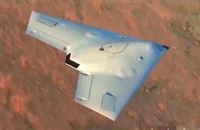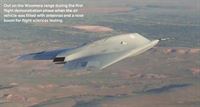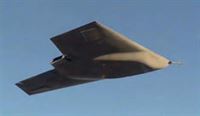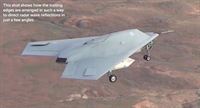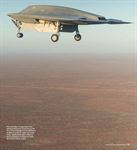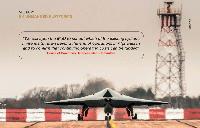
Фотографии
-
Air International 2014-03 / News
Регистрационный номер: ZZ250 [20] With a wing sweep of approximately 60° the Taranis is subtly different in plan form to other similar unmanned air vehicle demonstrators.
-
Air International 2014-10 / N.Beckett - Lifting the Veil /Technology/
Регистрационный номер: ZZ250 [20] -
Air International 2019-05 / M.Ayton - Made in England: Taranis /Technology/
Регистрационный номер: ZZ250 [20] Taranis ZZ250 airborne over the Woomera test range in South Australia.
Antennas fitted to the air vehicle’s fuselage underside for flight sciences testing appear to be positioned within under fuselage panels. -
Air International 2019-05 / M.Ayton - Made in England: Taranis /Technology/
Регистрационный номер: ZZ250 [20] Great top-down view of the Taranis air vehicle shows the curved configuration of the upper fuselage surfaces, the edge treatments of the wing and control surfaces, the fuselage forward of the intake, and the narrow engine exhaust positioned on the upper surface.
-
Air International 2019-05 / M.Ayton - Made in England: Taranis /Technology/
Регистрационный номер: ZZ250 [20] Taranis is shaped to achieve specular scattering of radar waves such that they bounce off the structure; the fuselage shape and articulation is formed to minimise the returns to a radar.
-
Air International 2014-03 / News
Регистрационный номер: ZZ250 [20] Top: Top down view of Taranis airborne over the Woomera test range with its distinctive red earth.
Bottom: Air-to-air shot of Taranis ZZ250 showing the design form of the fuselage, wings and nozzle. -
Air International 2019-05 / M.Ayton - Made in England: Taranis /Technology/
Регистрационный номер: ZZ250 [20] Out on the Woomera range during the first flight demonstration phase when the air vehicle was fitted with antennas and a nose boom for flight sciences testing.
-
Air International 2019-05 / M.Ayton - Made in England: Taranis /Technology/
Регистрационный номер: ZZ250 [20] Note how the curved form of the upper fuselage meets the leading edge of the engine intake at an apex.
-
Air International 2019-05 / M.Ayton - Made in England: Taranis /Technology/
Регистрационный номер: ZZ250 [20] The fuselage underside resembles the hull of a boat. The lower surface is gently curved and meets the upper surface at an acute angle to limit the angles of specular reflections.
-
Air International 2019-05 / M.Ayton - Made in England: Taranis /Technology/
Регистрационный номер: ZZ250 [20] Main landing gear doors open toward the aircraft centreline rather than toward the wing tip as is the case with the American B-2 bomber and the X-47B unmanned combat air system demonstrator.
-
Air International 2014-03 / News
Регистрационный номер: ZZ250 [20] Top: Taranis with the landing gear doors open.
Bottom: Taranis with the landing gear in retraction. -
Air International 2019-05 / M.Ayton - Made in England: Taranis /Technology/
Регистрационный номер: ZZ250 [20] This shot shows how the trailing edges are arranged in such a way to direct radar wave reflections in just a few angles.
-
Air International 2019-05 / M.Ayton - Made in England: Taranis /Technology/
Регистрационный номер: ZZ250 [20] This shot taken on approach to the airfield at Woomera shows the curved form of the fuselage and the difference in depth between its upper and lower forms. Depth of the upper surface is such to house an S-shaped air intake duct and an Adour engine.
-
Air International 2021-09 / S.Beal - Future force
Регистрационный номер: ZZ250 [20] Британский «беспилотник» «Таранис»
Cousin of the XB-47? Image of Taranis, Unmanned Combat Air Vehicle (UCAV), Taxiing at BAE Systems facility in Warton, Lancashire. Developed in 2013, Taranis was one of the RAF's first attempts to develop an uninhabited combat air system. This shot gives a sense of how large the main landing gear doors are. -
Air International 2014-07 / M.Broadbent - Decisions Decisions /Military/
Регистрационный номер: ZZ250 [20] -
Air International 2019-05 / M.Ayton - Made in England: Taranis /Technology/
Регистрационный номер: ZZ250 [20] This head-on shot shows how BAE Systems blackened the air vehicle's air intake to prevent visual acquisition of its internal form.
-
Air International 2014-07 / M.Broadbent - Decisions Decisions /Military/
Регистрационный номер: ZZ250 [20] The BAE Systems Taranis during trials at Warton.
-
Air International 2014-03 / News
Регистрационный номер: ZZ250 [20] Loading on to an RAF C-17A ZZ173 at Warton on May 18, 2013.
Другие самолёты на фотографии: McDonnell Douglas C-17A Globemaster III - США - 1991
-
Air International 2012-08 / N.Beckett - Taranis /Technology/
Регистрационный номер: ZZ250 [20] -
Air International 2014-10 / N.Beckett - Lifting the Veil /Technology/
Регистрационный номер: ZZ250 [20] Taranis undergoing tests on the BAE Systems Warton radar range
-
Air International 1990-11 / Airdata File
Models on the British Aerospace stand showed a possible "stealth" configuration;
-
Air International 2007-12 / A.Brookes - Death Knell For UK Aerospace? /Military/
Increasing interest in unmanned air vehicles to replace manned aircraft is analogous to the thinking behind the White Paper 50 years ago, when it was proposed to use missiles to carry out some of the tasks performed by combat aircraft.
-
Air International 2007-01 / News: Headline, Military, Civil, Accidents
Artist's impression of what the BAE Systems Taranis UAV technology demonstrator might look like.
BAE Systems has been awarded a contract to develop an autonomous unmanned air vehicle under Project Taranis. In addition to being able to carry ground attack weapons, the UAV will have the capability to remain airborne for over 24 hours. This artist's impression illustrates what the technology demonstrator might look like.




